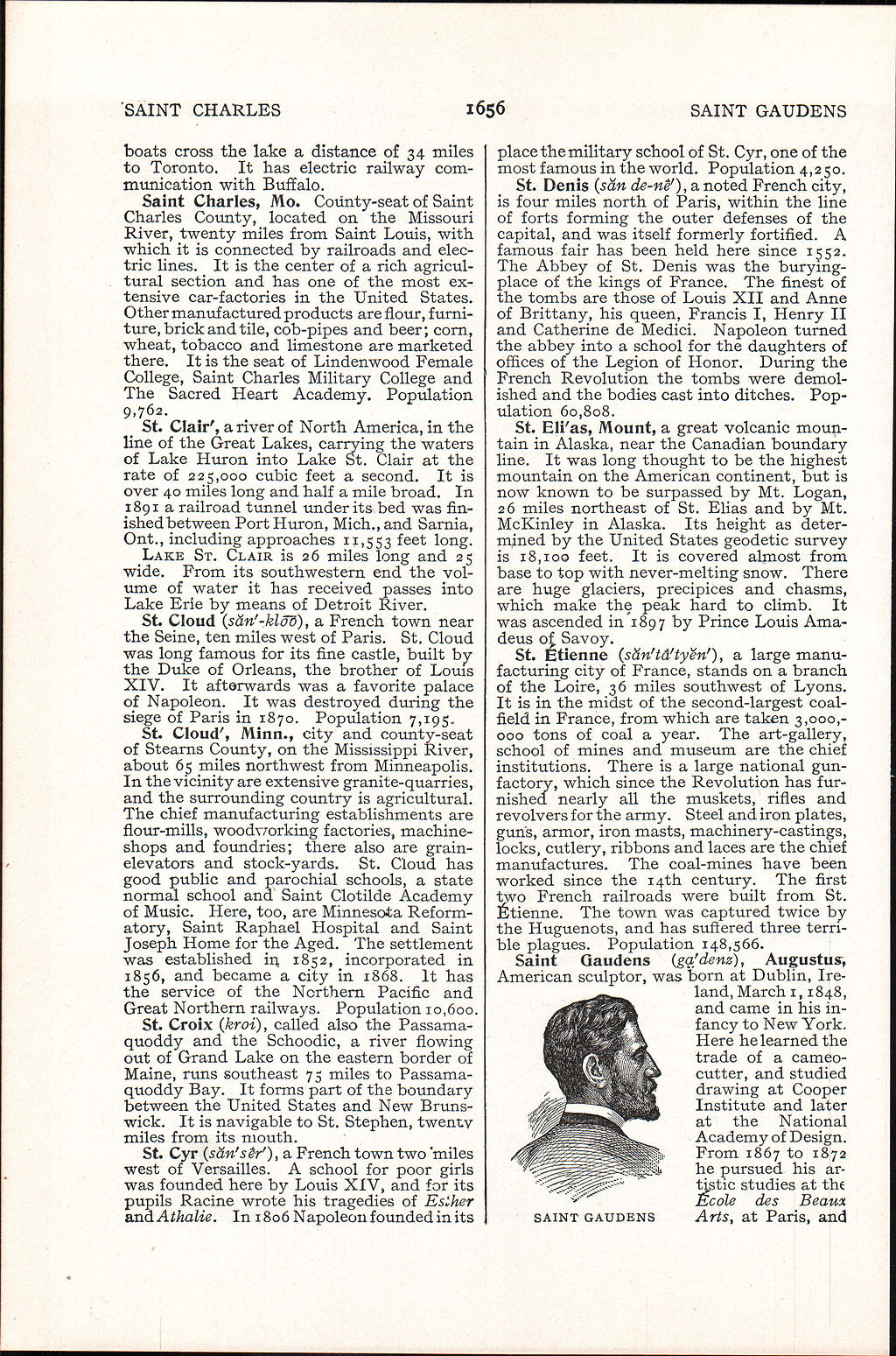'SAINT CHARLES
1656
SAINT GAUDENS
boats cross the lake a distance of 34 miles to Toronto. It has electric railway communication with Buffalo.
Saint Charles, Mo. County-seat of Saint Charles County, located on the Missouri River, twenty miles from Saint Louis, with which it is connected by railroads and electric lines. It is the center of a rich agricultural section and has one of the most extensive car-factories in the United States. Other manufactured products are flour, furniture, brick and tile, cob-pipes and beer; corn, wheat, tobacco and limestone are marketed there. It is the seat of Lindenwood Female College, Saint Charles Military College and The Sacred Heart Academy. Population 9,762.
St. Clair', a river of North America, in the line of the Great Lakes, carrying the waters of Lake Huron into Lake St. Clair at the rate of 225,000 cubic feet a second. It is over 40 miles long and half a mile broad. In 1891 a railroad tunnel under its bed was finished between Port Huron, Mich., and Sarnia, Ont., including approaches 11,553 feet long.
LAKE ST. CLAIR is 26 miles long and 25 wide. From its southwestern end the volume of water it has received passes into Lake Erie by means of Detroit River.
St. Cloud (s&n'-klffi), a French town near the Seine, ten miles w^est of Paris. St. Cloud was long famous for its fine castle, built by the Duke of Orleans, the brother of Louis XIV. It afterwards was a favorite palace of Napoleon. It was destroyed during the siege of Paris in 1870. Population 7,195.,
St. Cloud', Minn., city and county-seat of Stearns County, on the Mississippi River, about 65 miles northwest from Minneapolis. In the vicinity are extensive granite-quarries, and the surrounding country is agricultural. The chief manufacturing establishments are flour-mills, woodv/x)rking factories, machine-shops and foundries; there also are grain-elevators and stock-yards. St. Cloud has good public and parochial schools, a state normal school and Saint Clotilde Academy of Music. Here, too, are Minnesota Reformatory, Saint Raphael Hospital and Saint Joseph Home for the Aged. The settlement was established in, 1852, incorporated in 1856, and became a city in 1868. It has the service of the Northern Pacific and Great Northern railways. Population 10,600.
St. Croix (kroi), called also the Passama-quoddy and the Schoodic, a river flowing out of Grand Lake on the eastern border of Maine, runs southeast 75 miles to Passama-quoddy Bay. It forms part of the boundary between the United States and New Brunswick. It is navigable to St. Stephen, twentv miles from its mouth.
St. Cyr (s&n's$r')t a French town two "miles west of Versailles. A school for poor girls was founded here by Louis XIV, and for its pupils Racine wrote his tragedies of Esther and Athalie. In 1806 Napoleon founded in its
place the military school of St. Cyr, one of the most famous in the world. Population 4,250. St. Denis (sdn de-nef),& noted French city, is four miles north of Paris, within the line of forts forming the outer defenses of the capital, and was itself formerly fortified. A famous fair has been held here since 1^52. The Abbey of St. Denis was the burying-place of the kings of France. The finest of the tombs are those of Louis XII and Anne of Brittany, his queen, Francis I, Henry II and Catherine de Medici. Napoleon turned the abbey into a school for the daughters of offices of the Legion of Honor. During the French Revolution the tombs were demolished and the bodies cast into ditches. Population 60,808.
St. Eli'as, Mount, a great volcanic mountain in Alaska, near the Canadian boundary line. It was long thought to be the highest mountain on the American continent, but is now known to be surpassed by Mt. Logan, 26 miles northeast of St. Elias and by Mt. McKinley in Alaska. Its height as deter-m^ned by the United States geodetic survey is 18,100 feet. It is covered almost from base to top with never-melting snow. There are huge glaciers, precipices and chasms, which make the peak hard to climb. It was ascended in'189 7 by Prince Louis Ama-deus of Savoy.
St. Etienne (stin'ta'ty>en'), a large manufacturing city of France, stands on a branch of the Loire, 36 miles southwest of Lyons. It is in the midst of the second-largest coalfield in France, from which are taken 3,000,-ooo tons of coal a year. The art-gallery, school of mines and museum are the chief institutions. There is a large national gun-factory, which since the Revolution has furnished nearly all the muskets, rifles and revolvers for the army. Steel and iron plates, guns, armor, iron masts, machinery-castings, locks, cutlery, ribbons and laces are the chief manufactures. The coal-mines have been worked since the i4th century. The first two French railroads were built from St. fitienne. The town was captured twice by the Huguenots, and has suffered three terrible plagues. Population 148,566.
Saint Qaudens (ga'denz), Augustus, American sculptor, was born at Dublin, Ireland, March i, 1848, and came in his infancy to New York. Here he learned the trade of a cameo-cutter, and studied drawing at Cooper Institute and later at the National Academy of Design. From 1867 to 1872 he pursued his artistic studies at th€ Ecole des Beany. Arts, at Paris, and
SAINT GAUDENS
